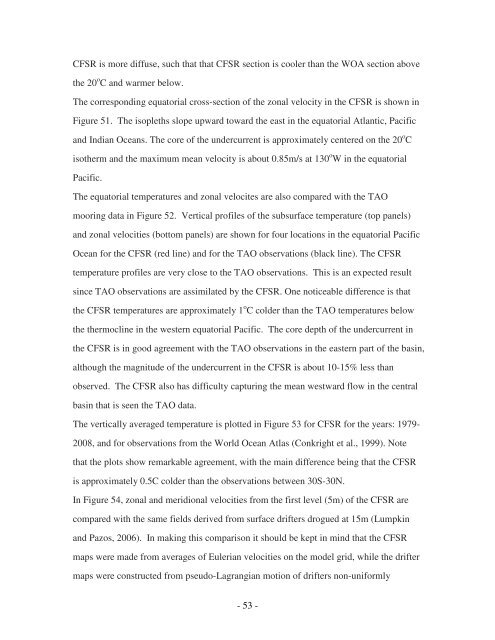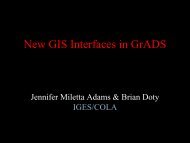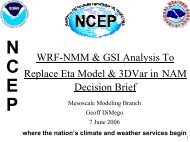The NCEP Climate Forecast System Reanalysis - NOAA National ...
The NCEP Climate Forecast System Reanalysis - NOAA National ...
The NCEP Climate Forecast System Reanalysis - NOAA National ...
You also want an ePaper? Increase the reach of your titles
YUMPU automatically turns print PDFs into web optimized ePapers that Google loves.
CFSR is more diffuse, such that that CFSR section is cooler than the WOA section abovethe 20 o C and warmer below.<strong>The</strong> corresponding equatorial cross-section of the zonal velocity in the CFSR is shown inFigure 51. <strong>The</strong> isopleths slope upward toward the east in the equatorial Atlantic, Pacificand Indian Oceans. <strong>The</strong> core of the undercurrent is approximately centered on the 20 o Cisotherm and the maximum mean velocity is about 0.85m/s at 130 o W in the equatorialPacific.<strong>The</strong> equatorial temperatures and zonal velocites are also compared with the TAOmooring data in Figure 52. Vertical profiles of the subsurface temperature (top panels)and zonal velocities (bottom panels) are shown for four locations in the equatorial PacificOcean for the CFSR (red line) and for the TAO observations (black line). <strong>The</strong> CFSRtemperature profiles are very close to the TAO observations. This is an expected resultsince TAO observations are assimilated by the CFSR. One noticeable difference is thatthe CFSR temperatures are approximately 1 o C colder than the TAO temperatures belowthe thermocline in the western equatorial Pacific. <strong>The</strong> core depth of the undercurrent inthe CFSR is in good agreement with the TAO observations in the eastern part of the basin,although the magnitude of the undercurrent in the CFSR is about 10-15% less thanobserved. <strong>The</strong> CFSR also has difficulty capturing the mean westward flow in the centralbasin that is seen the TAO data.<strong>The</strong> vertically averaged temperature is plotted in Figure 53 for CFSR for the years: 1979-2008, and for observations from the World Ocean Atlas (Conkright et al., 1999). Notethat the plots show remarkable agreement, with the main difference being that the CFSRis approximately 0.5C colder than the observations between 30S-30N.In Figure 54, zonal and meridional velocities from the first level (5m) of the CFSR arecompared with the same fields derived from surface drifters drogued at 15m (Lumpkinand Pazos, 2006). In making this comparison it should be kept in mind that the CFSRmaps were made from averages of Eulerian velocities on the model grid, while the driftermaps were constructed from pseudo-Lagrangian motion of drifters non-uniformly- 53 -





